Abstract
A new approach to simulating fracture, in which toughness is partitioned between the crack tip and, optionally, a process zone, is applied to dynamic fracture processes. In this approach, classical fracture mechanics determines crack tip propagation, and cohesive laws characterize process zone response and determine crack root and process zone propagation. The approach is implemented in the Material Point Method, a particle method in which the fracture path is unconstrained by a body-fitted mesh. The approach is found suitable for modeling a range of dynamic fracture processes, from brittle fracture to fracture with crack bridging. A variety of ways of partitioning toughness are explored with the aim of distinguishing model parameters via experimental measurements, particularly R curves. While no unique relationship exists, R curves, or effective R curves, on a suite of materials would provide substantial insight into model parameters. Advantages to the approach are identified, both in versatility and in regards to practical matters associated with implementing numerical fracture algorithms. It is found to perform well in dynamic fracture scenarios.
Similar content being viewed by others
References
Abu Al-Rub RK, Kim S-M (2010) Computational applications of a coupled plasticity-damage constitutive model for simulating plain concrete fracture. Eng Fract Mech 77: 1577–1603
Arias I, Knap J, Chalivendra V, Hong S, Ortiz M, Rosakis A (2007) Numerical modelling and experimental validation of dynamic fracture events along weak planes. Comput Methods Appl Mech Eng 196(37–40): 3833–3840
Atluri S, Zhu T (2000) New concepts in meshless methods. Int J Numer Methods Eng 47(1–3): 537–556
Babuska I, Melenk J (1997) The partition of unity method. Int J Numer Methods Eng 40(4): 727–758
Bardenhagen S, Kober E (2004) The generalized interpolation Material Point Method. Comput Model Eng Sci 5(6): 477–496
Belytschko T, Krongauz Y, Organ D, Fleming M, Krysl P (1996) Meshless methods: an overview and recent developments. Comput Methods Appl Mech Eng 139(1–4): 3–47
Bentur A, Mindess S (2006) Fibre reinforced cementitious composites Spons Architecture Price Book
Blackman B, Hadavinia H, Kinloch A, Williams J (2003) The use of a cohesive zone model to study the fracture of fibre composites and adhesively-bonded joints. Int J Fract 119(1): 25–46
Borst R, Remmers J, Needleman A (2006) Mesh-independent discrete numerical representations of cohesive-zone models. Eng Fract Mech 73(2): 160–177
Brackbill J, Kothe D, Ruppel H (1988) FLIP: a low-dissipation, particle-in-cell method for fluid flow. Comput Phys Commun 48(1): 25–38
Burgess D, Sulsky D, Brackbill J (1992) Mass matrix formulation of the FLIP particle-in-cell method. J Comput Phys 103(1): 1–15
Chen L, Zhang YY (2010) Dynamic fracture analysis using discrete cohesive crack method. Int J Numer Method Biomed Eng 26(11): 1493–1502. doi:10.1002/cnm.1232
Damjanac B, Detournay E (1995) Numerical modeling of normal wedge indentation in rocks. In: 35th US Symposium on Rock Mechanics. AA Balkema, Rotterdam, Netherlands, pp 349–354
Daphalapurkar N, Lu H, Coker D, Komanduri R (2007) Simulation of dynamic crack growth using the generalized interpolation material point (GIMP) method. Int J Fract 143(1): 79–102
Demkowicz L, Oden J (1986) An adaptive characteristic Petrov-Galerkin finite element method for convection-dominated linear and nonlinear parabolic problems in one space variable. J Comput Phys 67(1): 188–213
Dugdale D (1960) Yielding of steel sheets containing slits. J Mech Phys Solids 8(2): 100–104
Graham-Brady L (2010) Statistical characterization of meso-scale uniaxial compressive strength in brittle materials with randomly occurring flaws. Int J Solids Struct 47: 2398–2413
Guo Y, Nairn J (2004) Calculation of J-integral and stress intensity factors using the Material Point Method. Comput Model Eng Sci 6: 295–308
Guo Y, Nairn J (2006) Three-dimensional dynamic fracture analysis using the Material Point Method. Comput Model Eng Sci 16(3): 141
Ha YD, Bobaru F (2010) Studies of dynamic crack propagation and crack branching with peridynamics. Int J Fract 162(1–2): 229–244
Harlow F (1964) The particle-in-cell computing method for fluid dynamics. Methods Comput Phys 3: 319–343
Huang H, Detournay E, Bellier B (1999) Discrete element modelling of rock cutting
Johnson C (1987) Numerical solution of partial differential equations by the finite element method. Cambridge University Press, Cambridge
Khoei A, Moslemi H, Majd Ardakany K, Barani O, Azadi H (2009) Modeling of cohesive crack growth using an adaptive mesh refinement via the modified-SPR technique. Int J Fract 159(1): 21–41
Li L, Liu S, Wang H (2011) A meshless method for ductile fracture. Int J Numer Method Biomed Eng 27(2): 251–261
Li S, Liu WK (2002) Meshfree and particle methods and their applications. Appl Mech Rev 55(1): 1–34
Liu C, Stout M, Asay B (2000) Stress bridging in a heterogeneous material. Eng Fract Mech 67(1): 1–20
Matsumoto N, Nairn J (2009) The fracture toughness of medium density fiberboard (MDF) including the effects of fiber bridging and crack-plane interference. Eng Fract Mech 76(18): 2748–2757
Matsumoto N, Nairn J (2010) Fracture toughness of wood and wood composites during crack propagation. Wood Fiber sci (submitted)
Nairn J (2009) Analytical and numerical modeling of R curves for cracks with bridging zones. Int J Fract 155(2): 167–181
Needleman A (1999) An analysis of intersonic crack growth under shear loading. J Appl Mech 66: 847
Nishioka T (1997) Computational dynamic fracture mechanics. Int J Fract 86(1): 127–159
Nishioka T, Atluri S (1983) Path-independent integrals, energy release rates, and general solutions of near-tip fields in mixed-mode dynamic fracture mechanics. Eng Fract Mech 18(1): 1–22
Nistor I, PantalÈ O, Caperaa S (2008) Numerical implementation of the eXtended Finite Element Method for dynamic crack analysis. Adv Eng softw 39(7): 573–587
Pandolfi A, Ortiz M (2002) An efficient adaptive procedure for three-dimensional fragmentation simulations. Eng Comput 18(2): 148–159
Rosakis A, Samudrala O, Coker D (1999) Cracks faster than the shear wave speed. Science 284(5418): 1337
Silling SA (2000) Reformulation of elasticity theory for discontinuities and long-range forces. J Mech Phys Solids 48(1): 175–209. doi:10.1016/s0022-5096(99)00029-0
Sulsky D, Chen Z, Schreyer H (1994) A particle method for history-dependent materials. Comput Methods Appl Mech Eng 118(1–2): 179–196
Sulsky D, Zhou S, Schreyer H (1995) Application of a particle-in-cell method to solid mechanics. Comput Phys Commun 87(1–2): 236–252
Xu X, Needleman A (1994) Numerical simulations of fast crack growth in brittle solids. J Mech Phys Solids 42(9): 1397–1434
Author information
Authors and Affiliations
Corresponding author
Rights and permissions
About this article
Cite this article
Bardenhagen, S.G., Nairn, J.A. & Lu, H. Simulation of dynamic fracture with the Material Point Method using a mixed J-integral and cohesive law approach. Int J Fract 170, 49–66 (2011). https://doi.org/10.1007/s10704-011-9602-1
Received:
Accepted:
Published:
Issue Date:
DOI: https://doi.org/10.1007/s10704-011-9602-1




